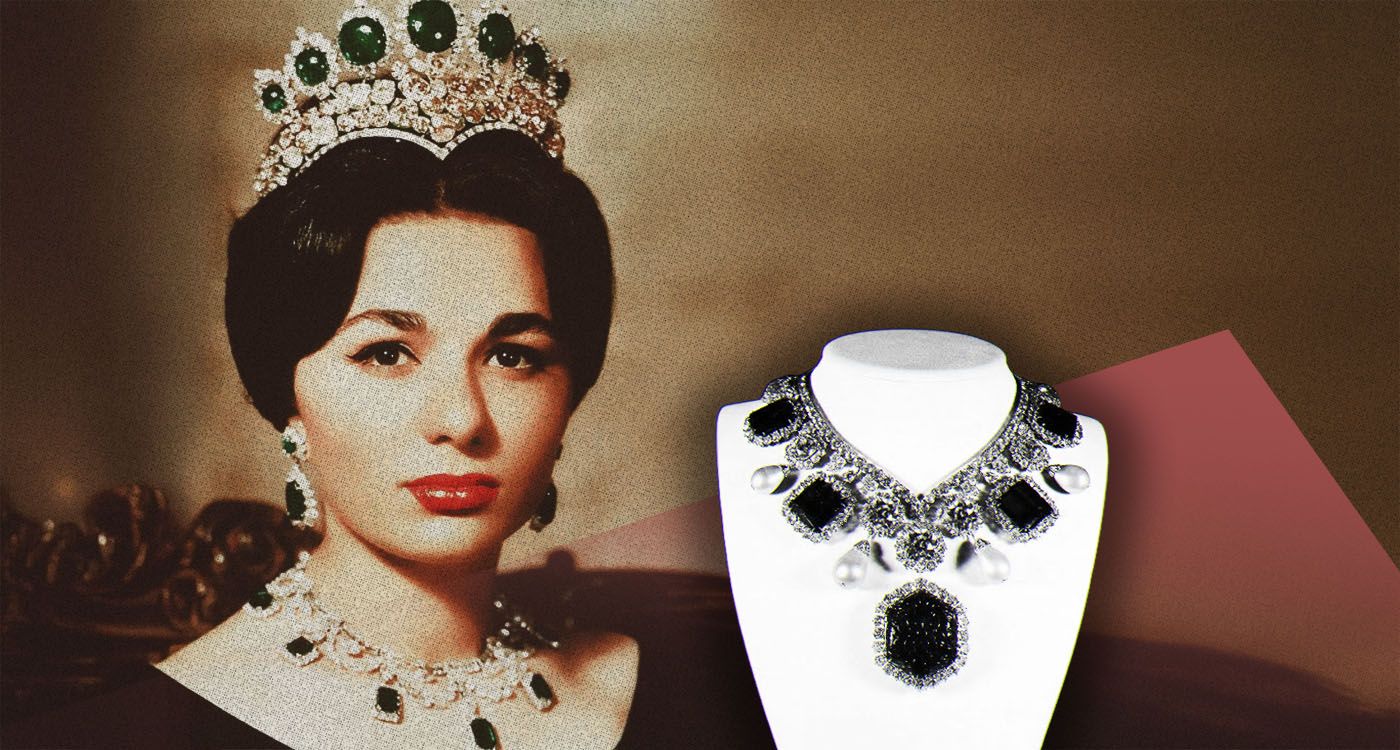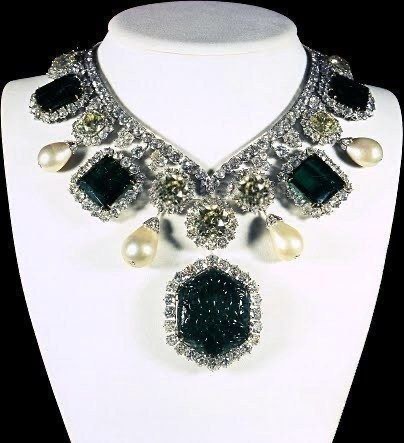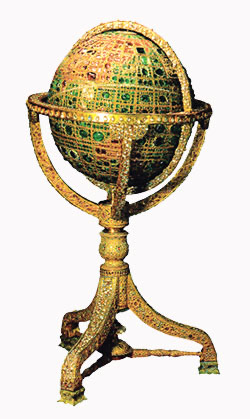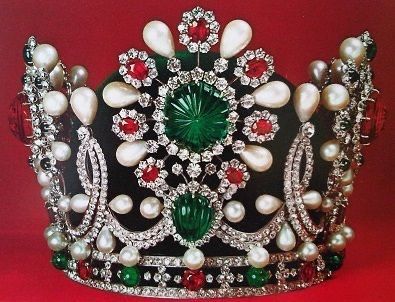
More precious than the British Crown Jewels, Iran’s imperial treasure gleams in the vaults of the Central Bank in Tehran. A legacy of royal conquest, it embodies five centuries of Persian splendor—now carefully preserved behind glass display cases.
It’s a treasure few have seen, yet one that specialists regard with awe. Behind armored doors, deep within the basement of Tehran’s Central Bank, lies what some historians consider the world’s most valuable collection of jewels—surpassing even those of the British monarchy.
Amassed over more than 500 years of imperial history and expanded through the conquests of the Safavids, Qajars, and Pahlavis, the trove includes pieces from India, Central Asia, the Caucasus, and the Ottoman Empire. Each item tells a story—the story of an empire that, until 1979, believed it would endure forever.

Farah Diba married the Shah and became the Shahbanou: here is her necklace created by Van Cleef & Arpels with gems from the Iranian treasure.© www.teheran.ir
Darya-i-Noor: The Crown of All Jewels
At the heart of this legendary collection shines a diamond few museums could ever hope to display: The Darya-i-Noor— “Sea of Light.” This pale pink, 182-carat gem is believed to be the largest cut pink diamond in the world. Mined in India’s Golconda region, it once belonged to the Mughal emperors before being seized by Nader Shah during his 1739 invasion of Delhi.
Yet the Darya-i-Noor is accompanied by its “twin,” the Noor-ul-Ain—roughly 60 carats—set in a tiara worn by Empress Farah Pahlavi at her 1967 coronation. She was the first Iranian empress to be officially crowned, and the image of her adorned with these spectacular stones remains a powerful symbol of the monarchy’s golden age.

The Darya-i-Noor— “Sea of Light.” This pale pink, 182-carat gem is believed to be the largest cut pink diamond in the world. © www.teheran.ir
Dismountable Thrones and Gemstone Spheres
The splendor of this era extends far beyond tiaras. The treasure also holds extraordinary symbols of power, such as the Takht-e Tavous—the Peacock Throne—a monumental seat encrusted with more than 26,700 gems, including emeralds, diamonds, rubies, and pearls. Crafted in the 19th century to impress foreign courts, it should not be confused with the Mughal throne of the same name. Yet the reference is deliberate: Iran sought to rival its neighbors in grandeur and majesty.
Even more remarkable is the Naderi Throne, designed to be dismantled into twelve pieces so it could accompany the Shah to his summer palaces. This ingenious design allowed the transfer of power without compromising ceremony or decorum.
The collection also includes swords inlaid with gems, belts set with emeralds weighing over 170 carats, necklaces made of giant pearls, ornate feathered headdresses, diamond-studded leather shields, and countless other ceremonial pieces.

The solid gold globe made in 1874. © www.teheran.ir
But the showstopper is undoubtedly the solid gold globe made in 1874. Weighing over 34 kilograms of pure gold, it is adorned with 51,366 precious stones. Emeralds form the oceans, rubies the continents, and diamonds mark imperial powers like Iran and the United Kingdom. This globe is a jeweled political map—a world shaped by masterful craftsmanship.
A Priceless National Treasure
After the Islamic Revolution, this treasure might have been lost in the turmoil of history. Instead, the Islamic Republic, despite its break with the monarchy, chose to preserve the entire heritage, placing it under the care of the Central Bank. No longer worn, the collection is now carefully catalogued, secured, and owned by the state.
Its economic role is unique: the treasure serves as an implicit guarantee for the national currency, the rial. Iranian economists say that, in the event of a severe collapse, the government could theoretically back its monetary policy with the immense value of this collection.

The crown worn by Farah Diba at her 1967 coronation—crafted by Van Cleef & Arpels from Iran’s imperial gems—is now exhibited at the Central Bank of Tehran. © www.teheran.ir
Some experts estimate its worth at hundreds of billions of dollars, though no official appraisal exists due to the unique nature of the pieces.
The greatest paradox lies in the connection between this royal treasure and today’s theocratic regime. Born in opposition to the monarchy, the regime nonetheless preserves, cares for, and occasionally displays artifacts from the former dynasty. The treasure is open to visitors a few days a week, yet it lacks advertising, an official website, or any presence on major tourist routes.
This discretion is both intentional and political. How do you showcase Farah Diba’s golden crowns in a republic founded on “religious modesty” and anti-imperialism? Yet no one even considers discarding them—the treasure’s symbolic power and strategic significance transcend any regime. And that is hard to deny.
The World’s Greatest Treasure Without a UNESCO Seal
Despite its priceless value and historical significance, Iran’s national imperial jewel collection is absent from the UNESCO World Heritage list. Unlike sites such as Golestan Palace or Persepolis—also in Iran—this collection has never been formally nominated.
Several factors explain this omission. First, the treasure is securely stored deep within the vaults of the Central Bank rather than housed in a public historic or architectural site. There is no dedicated museum or clear cultural policy supporting its display.
Second, the treasure’s political significance stands in the way. As a direct legacy of the fallen monarchy and closely tied to the Pahlavi family until 1979, it remains a sensitive subject for the Islamic Republic. For some, promoting it internationally risks appearing to endorse the extravagance of a regime they oppose.
Finally, UNESCO prioritizes nominations submitted by governments. Tehran has chosen silence on the matter, balancing strategic calculations with ideological caution. The result: the world’s greatest treasure remains officially… unrecognized.





Comments